Tyumen
Tyumen (/tjuːˈmɛn/ tew-MEN;[11][12] Russian: Тюмень, IPA: [tʲʉˈmʲenʲ] (![]()
Tyumen Тюмень | |
|---|---|
City[1] | |
-2.jpg) A view of central Tyumen | |
.png) Flag Coat of arms | |
Location of Tyumen 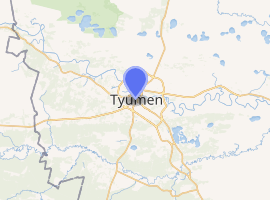
| |
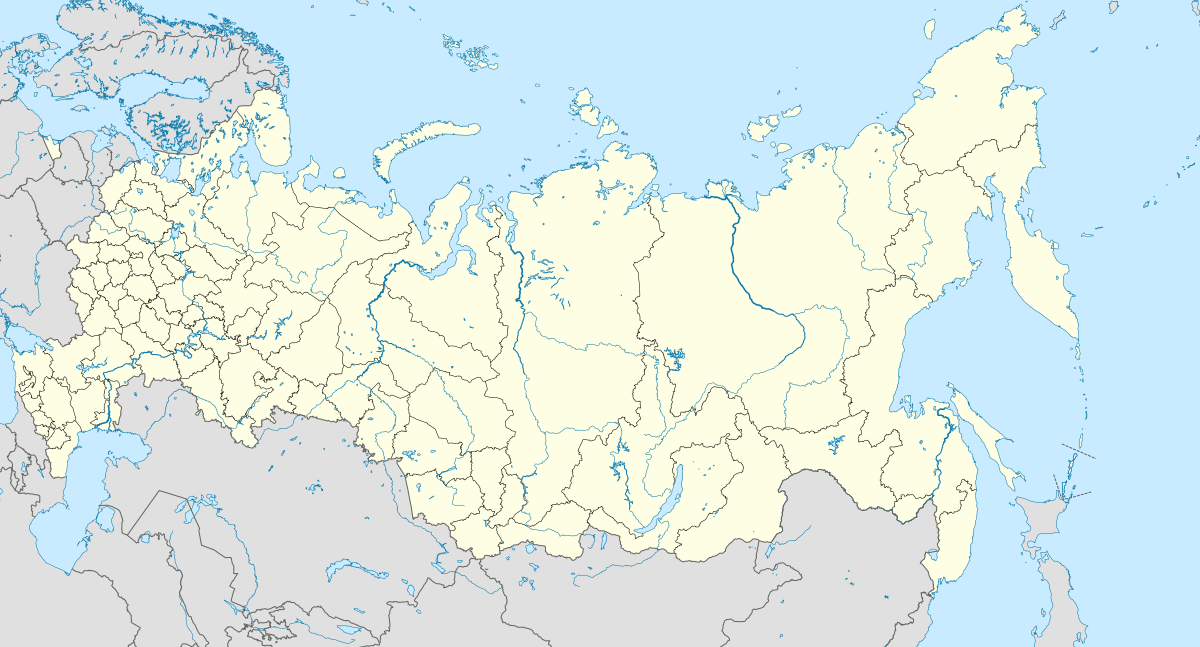 Tyumen Location of Tyumen 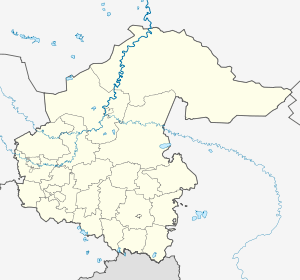 Tyumen Tyumen (Tyumen Oblast) | |
| Coordinates: 57°09′N 65°32′E | |
| Country | Russia |
| Federal subject | Tyumen Oblast[1] |
| Founded | July 29, 1586[2] |
| Government | |
| • Head of Administration[3] | Ruslan Kukharuk[3] |
| Area | |
| • Total | 698 km2 (269 sq mi) |
| Elevation | 102 m (335 ft) |
| Population | |
| • Total | 581,907 |
| • Estimate (2018)[6] | 768,358 (+32%) |
| • Rank | 25th in 2010 |
| • Density | 830/km2 (2,200/sq mi) |
| • Subordinated to | City of Tyumen[1] |
| • Capital of | Tyumen Oblast[4], Tyumensky District[1] |
| • Urban okrug | Tyumen Urban Okrug[7] |
| • Capital of | Tyumen Urban Okrug[7], Tyumensky Municipal District[7] |
| Time zone | UTC+5 (MSK+2 |
| Postal code(s)[9] | 625000–625010, 625013–625019, 625022, 625023, 625025–625039, 625041, 625043, 625046, 625048, 625049, 625051–625053, 625059, 625062, 625500, 625700, 625880, 625890, 625899, 625960, 625961–625965, 625970, 625991, 625992, 901163, 901165, 901167, 901169, 901171, 901205, 996000 |
| Dialing code(s) | +7 3452[10] |
| OKTMO ID | 71701000001 |
| City Day | Last Sunday of July[2] |
| Website | www |
Tyumen was the first Russian settlement in Siberia. Founded in 1586 to support Russia's eastward expansion, the city has remained one of the most important industrial and economic centers east of the Ural Mountains. Located at the junction of several important trade routes and with easy access to navigable waterways, Tyumen rapidly developed from a small military settlement to a large commercial and industrial city. The central part of Old Tyumen retains many historic buildings from throughout the city's history.
Today Tyumen is an important business center. It is the transport hub and industrial center of Tyumen Oblast — an oil-rich region bordering Kazakhstan — as well as the home of many companies active in Russia's oil and gas industry.
Geography
Tyumen covers an area of 235 square kilometers (91 sq mi).[4] Its primary geographical feature is the Tura River, which crosses the city from northwest to southeast. The river is navigable downstream of the city. The left bank of the Tura is a floodplain surrounded by gently rolling hills. The Tura is a shallow river with extensive marshlands.
The river floods during the snow melting season in the spring. The spring flood usually peaks in the second half of May,[13] when the river becomes 8–10 times wider than during the late-summer low water season. The city is protected from flooding by a dike which can withstand floods up to 8 meters (26 ft) high.[14] The highest ever flood water level in Tyumen was 9.15 meters (30.0 ft), recorded in 1979. More recently, in 2007, a water level of 7.76 was recorded.[15] In spring 2005, a flood higher than the critical 8 meters (26 ft) mark was expected,[16] but did not appear.
Climate
Tyumen has a humid continental climate (Köppen climate classification Dfb) with warm, somewhat humid summers and long, cold winters. The weather in the region is very changeable, and the temperature in town is always higher than in the surrounding area by a few degrees. The town area also attracts more precipitation. The average temperature in January is −16.7 °C (1.9 °F), with a record low of −50 °C (−58 °F) measured in February 1951. The average temperature in July is +18.6 °C (65.5 °F), with a record high of +38 °C (100 °F).
The average annual precipitation is 457 millimeters (18.0 in). The wettest year on record was 1943, with 581 millimeters (22.9 in), and the driest was 1917, with only 231 millimeters (9.1 in).[17]
| Climate data for Tyumen | |||||||||||||
|---|---|---|---|---|---|---|---|---|---|---|---|---|---|
| Month | Jan | Feb | Mar | Apr | May | Jun | Jul | Aug | Sep | Oct | Nov | Dec | Year |
| Record high °C (°F) | 5.6 (42.1) |
7.0 (44.6) |
17.1 (62.8) |
30.7 (87.3) |
34.9 (94.8) |
36.2 (97.2) |
37.5 (99.5) |
37.4 (99.3) |
31.2 (88.2) |
24.1 (75.4) |
12.8 (55.0) |
6.7 (44.1) |
37.5 (99.5) |
| Average high °C (°F) | −10.7 (12.7) |
−8.1 (17.4) |
0.1 (32.2) |
9.4 (48.9) |
17.7 (63.9) |
23.3 (73.9) |
24.5 (76.1) |
21.2 (70.2) |
14.7 (58.5) |
7.3 (45.1) |
−3.5 (25.7) |
−9.1 (15.6) |
7.2 (45.0) |
| Daily mean °C (°F) | −15.0 (5.0) |
−13.3 (8.1) |
−5.3 (22.5) |
3.7 (38.7) |
11.3 (52.3) |
17.1 (62.8) |
18.8 (65.8) |
15.8 (60.4) |
9.6 (49.3) |
3.1 (37.6) |
−7.0 (19.4) |
−13.0 (8.6) |
2.2 (36.0) |
| Average low °C (°F) | −19.2 (−2.6) |
−18.1 (−0.6) |
−10.4 (13.3) |
−1.3 (29.7) |
5.4 (41.7) |
11.3 (52.3) |
13.6 (56.5) |
11.1 (52.0) |
5.4 (41.7) |
−0.4 (31.3) |
−10.4 (13.3) |
−16.9 (1.6) |
−2.5 (27.5) |
| Record low °C (°F) | −46.2 (−51.2) |
−43.7 (−46.7) |
−38.4 (−37.1) |
−29.5 (−21.1) |
−10.2 (13.6) |
−1.9 (28.6) |
0.7 (33.3) |
−2.7 (27.1) |
−8.6 (16.5) |
−26.7 (−16.1) |
−41.0 (−41.8) |
−49.2 (−56.6) |
−49.2 (−56.6) |
| Average precipitation mm (inches) | 25 (1.0) |
15 (0.6) |
17 (0.7) |
23 (0.9) |
45 (1.8) |
55 (2.2) |
89 (3.5) |
60 (2.4) |
57 (2.2) |
38 (1.5) |
34 (1.3) |
27 (1.1) |
485 (19.1) |
| Average rainy days | 0.4 | 0.2 | 2 | 9 | 16 | 17 | 17 | 19 | 19 | 13 | 4 | 0 | 117 |
| Average snowy days | 24 | 19 | 15 | 8 | 4 | 0.2 | 0 | 0 | 2 | 11 | 20 | 23 | 126 |
| Average relative humidity (%) | 80 | 76 | 70 | 62 | 58 | 65 | 72 | 77 | 77 | 77 | 80 | 80 | 73 |
| Mean monthly sunshine hours | 68.2 | 123.2 | 167.4 | 243.0 | 272.8 | 300.0 | 328.6 | 238.7 | 165.0 | 102.3 | 69.0 | 55.8 | 2,134 |
| Source 1: Pogoda.ru.net[18] | |||||||||||||
| Source 2: Climatebase (sun, 1933–2011)[19] | |||||||||||||
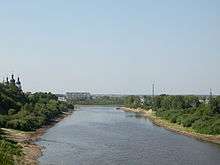
History
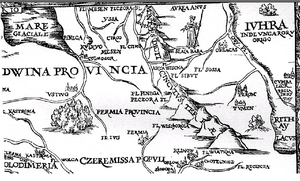
The Cossack ataman Yermak Timofeyevich annexed the Tyumen area, originally part of the Siberia Khanate, to the Tsardom of Russia in 1585. Both capitals of the Siberia Khanate, Sibir/Qashliq and Tyumen/Chimgi-Tura (the capital in the 15th century), were completely destroyed. Sibir was never rebuilt, though it gave its name to all concurrent and future lands in North Asia annexed by Russia, but Tyumen was later founded again. On July 29, 1586,[2] Tsar Feodor I ordered two regional commanders, Vasily Borisov-Sukin and Ivan Myasnoy, to construct a fortress on the site of the former Siberian Tatar town of Chingi-Tura ("city of Chingis"), also known as Tyumen, from the Turkish and Mongol word for "ten thousand"[20] – tumen.
Tyumen stood on the "Tyumen Portage", part of the historical trade route between Central Asia and the Volga region. Various South Siberian nomads had continuously contested control of the portage in the preceding centuries. As a result, Siberian Tatar and Kalmyk raiders often attacked early Russian settlers. The military situation meant that streltsy and Cossack garrisons stationed in the town predominated in the population of Tyumen until the mid-17th century. As the area became less restive, the town began to take on a less military character.
By the beginning of the 18th century Tyumen had developed into an important center of trade between Siberia and China in the east and Central Russia in the west. Tyumen had also become an important industrial center, known for leatherworkers, blacksmiths, and other craftsmen. In 1763, 7,000 people were recorded as living in the town.
In the 19th century the town's development continued. In 1836, the first steam boat in Siberia was built in Tyumen. In 1862, the telegraph came to the town, and in 1864 the first water mains were laid. Further prosperity came to Tyumen after the construction, in 1885, of the Trans-Siberian Railway. For some years, Tyumen was Russia's easternmost railhead, and the site of transhipment of cargoes between the railway and the cargo boats plying the Tura, Tobol, Irtysh, and Ob Rivers.
By the end of the 19th century Tyumen's population exceeded 30,000, surpassing that of its northern rival Tobolsk, and beginning a process whereby Tyumen gradually eclipsed the former regional capital. The growth of Tyumen culminated on August 14, 1944 when the city finally became the administrative center of the extensive Tyumen Oblast.

At the outbreak of the Russian Civil War in 1917, forces loyal to Admiral Alexander Kolchak and his Siberian White Army controlled Tyumen. However, the city fell to the Red Army on January 5, 1918.
During the 1930s, Tyumen became a major industrial center of the Soviet Union. By the onset of World War II, the city had several well-established industries, including shipbuilding, furniture manufacture, and the manufacture of fur and leather goods.
World War II saw rapid growth and development in the city. In the winter of 1941, twenty-two major industrial enterprises evacuated to Tyumen from the European part of the Soviet Union.[21] These enterprises went into operation the following spring. Additionally, war-time Tyumen became a "hospital city", where thousands of wounded soldiers were treated.
During Operation Barbarossa, when it seemed possible that Moscow would fall to the advancing German Army, Tyumen also became a refuge for the body of the Soviet leader Vladimir Lenin. Lenin's body was secretly moved from Lenin's mausoleum in Moscow (October 1941) to a hidden tomb located in what is now the Tyumen State Agriculture Academy[22] (former Tyumen Agriculture Institute).
Between 1941 and 1945 more than 20,000 Tyumen natives saw action at the front. Almost a third, about 6,000, perished in action (the exact number remains uncertain as official data includes non-local soldiers who died in Tyumen's hospitals).
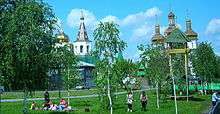
The town was affected by the discovery of rich oil- and gas-fields in the Tyumen Oblast in the 1960s. While most of these lay hundreds of kilometers away, near the towns of Surgut and Nizhnevartovsk, Tyumen was the nearest railway junction and so the city became their supply base while the railway was extended northwards.[23] As the result of this economic and population boom, with tens of thousands of skilled workers arriving from across the Soviet Union between 1963 and 1985, the rapid growth of the city also brought a host of problems. Its social infrastructure was limited and the lack of city planning has resulted in uneven development, with which Tyumen has continued to struggle.
Administrative and municipal status
Tyumen is the administrative center of the oblast and, within the framework of administrative divisions, it also serves as the administrative center of Tyumensky District, even though it is not a part of it.[1] As an administrative division, it is incorporated separately as the City of Tyumen—an administrative unit with the status equal to that of the districts.[1] As a municipal division, the City of Tyumen is incorporated as Tyumen Urban Okrug.[7]
City divisions
Tyumen is divided into four administrative okrugs: Kalininsky, Leninsky, Tsentralny, and Vostochny.
Government
City government
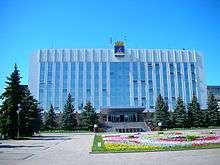
The legislative authority of Tyumen is the City Duma. In addition to legislative activities, the City Duma appoints the Head of the Tyumen City Administration, who is the chief executive officer of the city.
Oblast government
Since Tyumen is the administrative center of the oblast, all the governing bodies of the oblast are located in the city. They include the elected Legislative Assembly (Duma) of Tyumen Oblast, which also confirms the appointment of the Governor of Tyumen Oblast, who is nominated by the President of Russia.
Demographics
Tyumen's population grew steadily from the 16th century through the 19th century. However, when the Trans-Siberian Railway arrived at the end of the 19th century, the town's rate of population growth was greatly boosted. Tyumen rapidly became the largest town in the region, with about 30,000 inhabitants by the beginning of the 20th century. Tyumen again experienced rapid population growth with the coming of World War II. The evacuation of workers from factories in central Russia in 1941 more than doubled Tyumen's population to 150,000.
In the 1960s, the discovery of the rich oil and gas fields in Western Siberia caused the city's population, which had not been forecast to exceed 250,000 inhabitants that decade, to swell to almost half a million. After the growth of the 1960s, a period of population stability lasted until 1988, when economic depression hit the Soviet Union. The city's population in 1989 was 476,869, according to the census of that year. However, within five or six years Tyumen was again a major economic center with a rising population. By 2002, Tyumen's population had risen to 510,719. Further population growth (mainly due to migration and the incorporation of surrounding settlements) meant that by 2008 regional government statistics put Tyumen's population at 588,600 inhabitants.
Ethnic groups
While the population of Tyumen includes people from over a hundred different ethnicities, most belong to one of the following ethnicities:
Religion
.png)
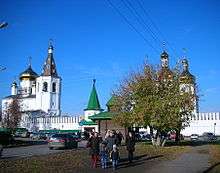
As of 2009, there are over ten operational Orthodox temples (both newly built and historical), two mosques (both newly built), one synagogue, and one Roman Catholic church in Tyumen.
Orthodox Christianity
While the state religion of the Russian Empire was Orthodoxy, this religion historically prevailed in Tyumen. In 1616, Trinity Monastery was established in Tyumen by Nifont of Kazan. In 1709–1711, this monastery was rebuilt in stone by the order of Filofey Leshchinsky, the first Metropolitan of Siberia. In 1761, the Tyumen Religious School was established. Overall, from 1708 to 1885, twelve stone Orthodox churches of different size, and two monasteries were constructed in Tyumen.
During Soviet times, two of the churches were completely destroyed, but the rest remained. As of 2008, most of them are accessible and operating.[24] Some operational churches are also under restoration. Tyumen Religious School was reopened in 1997.
Other religions
Despite the predominance of Orthodoxy, Catholic churches as well as mosques and synagogues were also built. However, only one Catholic church remains preserved. The Tyumen Mosque was completely destroyed, but its reconstruction on the same site caused controversy. The Tyumen synagogue collapsed in 2000, but was reconstructed on the same site. At the start of the 20th century, there was a strong Old Believers community in Tyumen.
All of the aforementioned religions operate cultural centers in Tyumen. There are also several other religious bodies with a few adherents in Tyumen.
Tyumen Trinity Monastery was built with special permission of Peter the Great. At the time, the construction of stone buildings outside Saint Petersburg was prohibited. The Church of Savior Uncreated was visited by Crown prince Alexandr (later Alexander II) during his Siberian tour.
Economy
Tyumen is an important service center for the gas and oil industries in Russia. Due to its advantageous location at the crossing of the motor, rail, water and air ways and its moderate climate Tyumen was an ideal base town for servicing the oil and gas industry of the West Siberia. As a result, today Tyumen is a center of industry, science, culture, education and medicine. Many large oil and gas companies such as Gazprom, LUKoil, Gazpromneft and Shell have their representative offices in Tyumen.
There are numerous factories, engineering companies, oil industry service companies (KCA DEUTAG and Schlumberger), design institutes, shipyard and other oil servicing companies located in Tyumen. Schwank, market leader for industrial heaters, has its subsidiary, SibSchwank, in Tyumen, holding market shares of about 25%.[25] UTair is also based in Tyumen.
Transportation
Railway

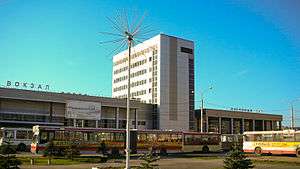
Tyumen railway station was built in 1885. Currently the station administratively belongs to the Tyumen Division of Sverdlovskaya Rail Road. The station is located in the center of the city. At the regional level, the station services three directions to Yekaterinburg, Omsk, and Tobolsk. The railroad to Yekaterinburg has been electrified since 1980. At the international level, the station services passage to (Trans-Siberian Railway): Poland, Germany, China, Mongolia, and Azerbaijan.
Additional stations within the city territory include: Tyumen North, Tyumen yard, Voynovka yard.
Public transportation
Public transportation in Tyumen is dominated by both municipal bus services and by numerous private operators (marshrutkas), which account for nearly a third of all transport capacity. The city's bus fleet is in process of modernization and expansion, with newly acquired Russian buses replacing the severely aged Soviet models.
Tyumen is a major hub for intercity bus service, centered on the bus terminal, which was constructed in 1972, and greatly expanded between 2006 and 2008.
Air transportation
Tyumen is served by the international Roschino Airport located 13 kilometres (8 miles) west of the city. In addition Plekhanovo Airport is in the area. The Roschino airport has permits to handle the following types of aircraft: Tu-154, Tu-134, An-12, An-24, An-26, Yak-40, Yak-42, IL-18, L-410, B-737, B-767, B-757, IL-86, IL-76, ATR-42, ATR-72, HS-125. The airport also has a permit to handle all types of helicopters. The airstrip is capable of handling large freight aircraft such as the An-22 Antaeus.
The city has a regular service to a large number of Russian towns, including, Moscow (9 flights a day), St. Petersburg, and Samara. There are also weekly or biweekly flights to the following international locations: Baku, Erevan, Khujand, and Tashkent.
Road
Tyumen is divided by the Tura River, the Tyumneka River, and the Trans-Siberian Railroad, creating several isolated zones. Ten bridges, one footbridge, seven flyovers, and five foot crossings connect these zones.
In addition, the road network was planned before the fall of the Soviet Union, and in its current state, it can operate normally only in the scheme which includes public transportation only. Compact planning of the city center prevents expansion of main roads; congestion coming from the city periphery moves slower and slower as it approaches the town center. To date, the road network serves about 200% above planned capacity, which leads to numerous traffic jams and high accident rates.
Since 2002, city and regional authorities have undertaken numerous initiatives to improve Tyumen's road network, but due to the continued growth of private automobile ownership rates, these efforts have only had short term positive effects. To date, a complex transport infrastructure reconstruction project is being directed by Regional Administration.[26] In January 2015, a paid parking program and prohibition of vehicle access for non-residents began.
Cityscape
Historically, Tyumen occupied a small area on the high bank of the Tura River around the foundation site of the city. The city consisted of one and two-storey wooden buildings, surrounded by a number of villages. With time, the territory of the city was developed and extended by including the surrounding villages.
When viewed from above, present-day Tyumen appears to be a collection of low-rise towns with occasional clusters of tall buildings. Two areas of the city, Yamskaya Sloboda and Republic Street are noted for their historic character. These areas are dominated by old brick and wooden merchant houses and buildings, with the occasional intrusion of mid-century Soviet low-rise buildings.

Bukharskaya Sloboda is a historic residential area on the low bank of the Tura river. This area is mostly made up of very old one and two-storey wooden buildings. The area is part of the Historical Centre on the city and has a mostly Muslim population. Low bank Dormitories is a cluster of standard 9-storey buildings was built on reclaimed land east of Bukharskaya Sloboda – Zareka and Vatutina.
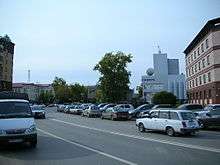
The area to the east of the historical town centre built between 1948 and 1978 and is mostly 4 and 5-storey buildings. Earlier buildings in this area have individual designs, but the later buildings have a rectangular style. This area contains most of the political and business activities of the town.
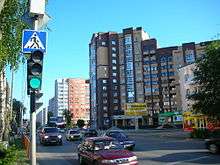
The modern area near the center of the town was built over demolished wooden houses and industrial areas. This area contains mostly tall buildings and is a mix of the dormitory areas and business centres.
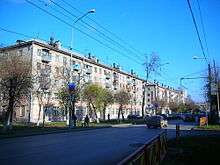
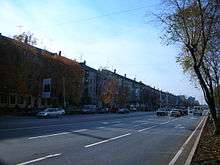
The Old Dormitories area features standard 5-storey blocks of flats constructed in the 1960s and 1970s at the west and east extremities of the city. However, today this area is actually in the town centre. While there are almost no variety in the area's architecture, this area has the most greenery in the city and the best social infrastructure.

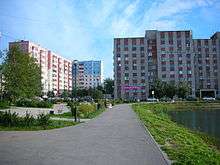
The New dormitories area features clusters of standard tall buildings constructed after 1980 at the south and south-east edges of Tyumen. This area is considered to be the worst place to live in the city. The area is remote, badly planned, and has very poor social infrastructure.
Architecture
Tyumen is not characterized by any particular architectural style. The town was built without planning for decades and because of that its architecture is an eclectic mix of buildings of different styles and eras.
Tyumen's nickname is the Capital of Villages because the most of its territory is built up by lumber houses. Many of the wooden buildings located in the historical part of the city are considered culturally valuable.
Society and culture
Leisure and entertainment


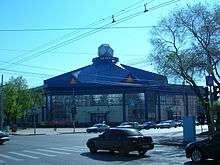
Tyumen has many cinemas and clubs. The city has had a Drama and Comedy Theater since 1858. There is a professional puppet show and the Angazhement Youth Theater. The Tyumen Music Hall is one of the most common venues for performances by Russian and foreign artists. Tyumen offers a great variety of cuisine in its numerous restaurants and bars. Annual events in the town include the Student Spring Music show and Day of The City Show.
Literature and film
A writer closely associated with the city is the children's writer Vladislav Krapivin. Author Mikhail M. Prishvin spent his youth in Tyumen, and Viktor L. Strogalschikov also lives in the city. Producer Konstantin V. Odegov was born and studied in Tyumen.
Museums and art galleries
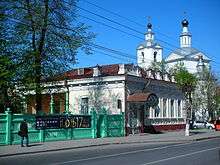
Museums and art galleries in Tyumen include the Tyumen Museum of Local Lore, the Tyumen Museum of the Fine Arts, Museum of Kolokolnikov estate and the Medical History Museum.
Music
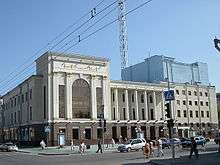
The town has its own philharmonic orchestra and the Tyumen Music hall hosts performances.
Sports

Many Soviet and Russian sportsmen started their careers in Tyumen youth sport, including Soviet cyclists Sergey Uslamin, Yury Korotkikh, and Oleg Polovnikov. Olympic biathlete siblings Anastasiya Kuzmina (née Shipulina) and Anton Shipulin were born and raised in the Tyumen area. The Tyumen Biathlon complex hosted a World Cup race series for the first time in March 2018.
Tyumen has a national level ice hockey team, soccer team and futsal team. There are three all-season ice arenas, a football pitch, a ski centre, a hippodrome, a shooting range, several tennis courts and three Olympic sized pools. In winter, parks for cross-country skiing are available around the town.
Important ice hockey and soccer teams are:
Education
Higher education
In 1964, Tyumen Industrial Institute was founded to supply the oil industry with a qualified local workforce. Many academies of different disciplines were founded in Tyumen after this, and now higher education is one of the major economic activities of the town. There are over 10 academies, including five universities in the town and dozens of colleges. In the educational year of 2008–2009 the five largest Academies of Tyumen together had over 110,000 students. Most students are not counted in the city population since they are non-residents of the Tyumen city according to Russian law.
Libraries
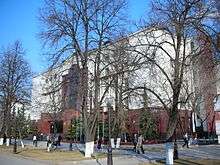
There are about fifty public libraries in Tyumen. In addition there are several corporate libraries integrated into public libraries book exchange system. The Tyumen Regional Scientific Library has about 2,670,000 units of issue in its stock.
Twin towns - sister cities
Tyumen is twinned with:[30]
Notable people
Natives of Tyumen
- Yevgeni Bushmanov, association football player and coach
- Sergey Fateev, journalist
- Yuri Aleksandrovich Gulyayev, opera singer
- Vladislav Krapivin, children's books writer
- Tamara Toumanova, ballerina and actress
- Anastasiya Kuzmina, Olympic biathlete
- Viktor Leonenko, association football player
- Vladilen Mashkovtsev, writer
- Irina Mataeva, soprano
- Nikolay Pereverzev, futsal player
- Abraham Walkowitz, painter
- Ksenia Sukhinova, Miss World 2008
- Andrei Vasilevskiy, professional hockey player (Tampa Bay Lightning-NHL)
- Anton Shipulin, Olympic biathlete
Other
- Nikolai Chukmaldin, merchant and enlightener
- Georg Wilhelm Steller, German scientist
- Alexander Aklepi, CEO Powernet Internetional and Cosite.com
See also
References
Notes
- Law No. 53
- "Charter of Tyumen (city proper) January 1, 2010. The Tyumen City Administration". Retrieved May 11, 2010.
- https://72.ru/text/gorod/55353361. Missing or empty
|title=(help) - "Geography of Tyumen (city proper), January 1, 2010. The City Government of Tyumen". Archived from the original on June 27, 2010. Retrieved May 11, 2010.
- Russian Federal State Statistics Service (2011). "Всероссийская перепись населения 2010 года. Том 1" [2010 All-Russian Population Census, vol. 1]. Всероссийская перепись населения 2010 года [2010 All-Russia Population Census] (in Russian). Federal State Statistics Service.
- "26. Численность постоянного населения Российской Федерации по муниципальным образованиям на 1 января 2018 года". Federal State Statistics Service. Retrieved January 23, 2019.
- Law No. 263
- "Об исчислении времени". Официальный интернет-портал правовой информации (in Russian). June 3, 2011. Retrieved January 19, 2019.
- Почта России. Информационно-вычислительный центр ОАСУ РПО. (Russian Post). Поиск объектов почтовой связи (Postal Objects Search) (in Russian)
- "Population of Tyumen (city proper)January 1, 2010. The City Government of Tyumen". Retrieved May 11, 2010.
- "Tyumen". Lexico UK Dictionary. Oxford University Press. Retrieved September 20, 2019.
- "Tyumen'". Merriam-Webster Dictionary. Retrieved September 20, 2019.
- В Тюмени готовятся к паводку (Tyumen is preparing for the spring flood) Archived June 15, 2009, at the Wayback Machine
- "Тюмени паводок не страшен (Flooding is no threat to Tyumen)". Archived from the original on September 8, 2012.
- "Уровень воды в р. Тура не превышает паводкового значения (Тюмень) (Water level in the Tura River does not exceed the [normal] spring-flood mark)". Archived from the original on January 17, 2012.
... максимальный уровень паводковых вод в Тюмени составил 9,15 м в 1979 г., а в 2007 г. он составлял 7,76 м.
- "Уровень воды в реке Тобол уже начал подниматься" [Water level in the Tobol has started to rise]. March 25, 2005.
Ожидается, что уровень воды в Туре превысит критический и достигнет восьми метров. (The water level in the Tura is expected to exceed the critical level and to reach 8 meters (26 ft)
- http://slovari.yandex.ru/dict/bse%7CGreat%5B%5D Soviet Encyclopedia
- "Tyumen Climate" (in Russian). Weather and Climate (Погода и климат). Archived from the original on December 8, 2015. Retrieved November 30, 2015.
- "Tjumen (Tyumen) Climatological Normals 1933–2011". Climatebase. Archived from the original on December 8, 2015. Retrieved November 30, 2015.
- E.M. Pospelov, Geograficheskie nazvaniya mira (Moscow: Russkie slovari, 1998), p. 427.
- http://www.tyumen-city.ru/gorodtumeny/istoriigoroda/pg1/106/%7C Archived April 16, 2016, at the Wayback Machine Official Site of Tyumen City History of the Town Section
- http://www.tsaa.ru/index.php?option=com_content&view=frontpage&Itemid=28 | Official Site of the Tyumen State Agriculture Academy
- Eric Newby, The Big Red Train Ride, Penguin 1980, p.99
- "Церкви, часовни и монастыри: Тюмень, город". www.temples.ru. Archived from the original on April 29, 2009.
- Chamber of Commerce Nuremberg: Short Description of the Region Tyumen / Kurzbeschreibung der Region Tjumen., Nuremberg 2008
- "Archived copy". Archived from the original on June 14, 2011. Retrieved July 23, 2009.CS1 maint: archived copy as title (link)
- "Общество - Тюмень: портал". www.tyumen-city.ru. Archived from the original on October 8, 2011.
- ТОП-10 регионов России по количеству легковых автомобилей, поставленных на госучет - Колеса.ру Archived March 24, 2016, at the Wayback Machine
- "Автомобилей в Тюмени больше, чем в Москве и Санкт-Петербурге / Новости Тюмени и Тюменской области - Наша Газета". ng72.ru. Archived from the original on March 27, 2016.
- "Города – побратимы города Тюмени". invest.tyumen-city.ru (in Russian). Tyumen. Retrieved February 1, 2020.
- 30.^Тюменьстат
Sources
- Тюменская областная Дума. Закон №53 от 4 ноября 1996 г. «Об административно-территориальном устройстве Тюменской области», в ред. Закона №47 от 7 мая 2015 г. «О внесении изменений в статьи 14 и 15 Закона Тюменской области "Об административно-территориальном устройстве Тюменской области"». Вступил в силу с момента официального опубликования. Опубликован: "Тюменские известия", №220, 12 ноября 1996 г. (Tyumen Oblast Duma. Law #53 of November 4, 1996 On the Administrative-Territorial Structure of Tyumen Oblast, as amended by the Law #47 of May 7, 2015 On Amending Articles 14 and 15 of the Law of Tyumen Oblast "On the Administrative-Territorial Structure of Tyumen Oblast". Effective as of the moment of official publication.).
- Тюменская областная Дума. Закон №263 от 5 ноября 2004 г. «Об установлении границ муниципальных образований Тюменской области и наделении их статусом муниципального района, городского округа и сельского поселения», в ред. Закона №39 от 7 мая 2015 г. «Об упразднении деревни Бурмистрова Балаганского сельского поселения Викуловского муниципального района Тюменской области и внесении изменений в отдельные Законы Тюменской области». Вступил в силу 1 января 2005 г. Опубликован: "Тюменская область сегодня", №213 (без приложений), 12 ноября 2004 г. (Tyumen Oblast Duma. Law #263 of November 5, 2004 On Establishing the Borders of the Municipal Formations of Tyumen Oblast and on Granting Them the Status of a Municipal District, Urban Okrug, and Rural Settlement, as amended by the Law #39 of May 7, 2015 On Abolishing the Village of Burmistrova in Balaganskoye Rural Settlement of Vikulovsky Municipal District of Tyumen Oblast and on Amending Various Laws of Tyumen Oblast. Effective as of January 1, 2005.).
External links
- Official website of Tyumen (in Russian)
